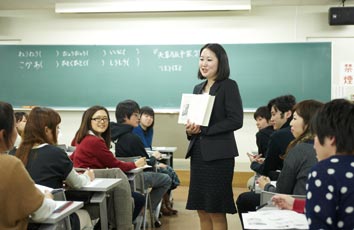
- 八王子キャンパス
文学部 日本文化学科

- 八王子キャンパス

日本文化の本質を理解し、
世界に発信できる人材を育成します
社会、日本語思想、芸術、宗教文化、大衆文化、近現代文学、思想、歴史、マンガ、アニメ、ファッションなど、いま世界中で日本の文化への関心が高まっています。日本文化学科では、多彩な文化に精通した教員陣の指導と独自のカリキュラムにより、日本文化の本質に多方面からアプローチ。日本文化に関する幅広い知識と、高度な日本語能力、そして文化を世界に伝えることができる国際的視野を備えた人材を育成します。

変化する言葉について学び、日本文化を分析する
犬の鳴き声『ワンワン』は、昔の人は『ビョウビョウ』などと表現していました。身近な言葉の移り変わりや現代の若者言葉、そして方言などをきっかけとして、日本語の歴史や日本文化を探っていく授業「日本語の歴史」。無意識に使っている言葉のなかに日本文化の分析につながる深い意味があることを理解し、学んだ知識を使って考える力、説明する力を身につけます。
1、2年次は少人数教育によるプレゼンテーション・表現・コミュニケーション能力を養成するとともに、日本文化に ついての基礎的な内容、広範囲かつ多様な知識を取得していきます。3、4年次では主体的かつ積極的に研究を進め、卒論に取り組みます。将来は、国語・社会・地理歴史や書道の教員、博物館の学芸員や図書館司書、出版やマスコミなど、さまざまな進路が開かれています。
日本文化演習 日本語学
「現代日本語分析(文法・意味・略語・翻訳・外来語)」「方言」「(狂言台本・キリシタン資料・江戸語資料を用いた)過去の日本語分析」「マンガやアニメのキャラクターたちが使用する言葉や文字」「花魁言葉」「命名」「効果的なプレゼンテーション」。これらは授業で実際に学生たちが発表したテーマの一部です。授業では、日本語をさまざまな視点から観察し、研究発表を行っています。前期は各時代の言語資料を用いながら、言語研究の仕方について学んでいます。後期は各自が興味を持ったテーマについて分析を進めています。
日本文化演習 古典文学
上代から近世までの古典文学作品を、さまざまな時代の古注釈と共に精読します。書誌調査、辞書や注釈書、参考文献の扱い方といった、読解・研究の基礎的な技術を学び、学生自らの問題提起を通して、仲間たちと共に作品について議論していきます。古い時代の注釈と共に、さまざまな時代の「知識の地層」を、その時代ごとの表現や知識とあわせて考えることで、幅広い知識と調査研究のための手法を身につけ、社会でも通じる幅広い問題解決能力を体得します。
伝統文化研究(江戸文化)
今から200年前、当時の人びとは何歳で結婚し、何人ぐらいの子どもを育て、何を思いながら生きていたのでしょうか。歴史に残るのは著名な人物に関する記録が中心で、一般の人びとについて語られることは限られています。この授業では、「幕府の人口統計」や「宗門改帳」などの資料を使って江戸時代を生きた一般民衆の一生にスポットを当てます。結婚や出産、家族構成など、彼らの素顔を記録からていねいに読み解いていきます。彼らのくらしを知ることは、現代を見つめ直す手がかりにもなります。歴史の中の「ふつうの人生」を探ってみませんか。
近代日本文化研究
個性あふれる十二支動物(ねずみ、牛、虎、兎、龍、蛇、馬、羊、猿、鶏、犬、猪)を導き手として、日本近代文化を列島の民俗・宗教などの伝統、伝承される物語とともに考察することで多面的に浮かび上がらせ、文化の継承・断絶・変容を学ぶ授業です。近代、伝統、物語の奥深く多彩な話題や知識にふれることができ、日本文化の担い手が人だけでなく、自然や生きものでもあることを発見していきます。また、十二支が年のみならず、年月日時・方位という時空を表す、東アジア共通の世界観であることを見出していきます。
日本文化研究(出版)
明治から昭和期の文学を、雑誌・新聞メディアとの関係性から学ぶ授業です。文学研究は現在の視点からだけでなく、〈書かれ〉〈流通し〉〈読まれた〉時代に即して理解することが重要です。本授業では、実際に流通した雑誌・新聞の実物を回覧しながら着目することで、掲載された作品や文豪といった文学コンテンツと同時代メディアとの意味合いを、歴史的・社会的・文化的な文脈から考察します。また、卒業論文の執筆や、他の授業において汎用可能な調査能力・フィールドワークスキルの向上もめざします。
日本文化研究(近代思想)
現代を生きる私たちにとって当たり前のことであっても、実はここ150年程度の間につくられたものもあります。例えば、小・中・高・大学という日本の学校制度も、近代(明治時代)以降につくられ、定着してきたものです。この授業では、明治から昭和期の日本人たちが、どのように激動の時代を理解しようとし、そのことが現代の私たちにどのような影響をおよぼしているのかを学びます。この授業を通して、自発的に物事を探求する能力を育みます。
GPA(Grade Point Average)制度の導入の趣旨は、1. キャンパスとして統一した基準を作成すること、2. 公平性に優れた基準であること、3. 国際的に通用する基準であることとし、学修の成果をGPAという客観的な数値で評価するものです。またこの制度は、欧米の大学で採用されている成績評価制度に概ね準拠しており、海外留学、海外の大学院進学、外資系企業への就職などの際に学力を証明する指標として、海外でも通用する成績評価制度となっています。
| 区分 | 評価 | GPA | 成績評価基準 | 評価内容 | 英文内容 |
|---|---|---|---|---|---|
| 合格 | S | 4.0 | 90点以上 | 特に優れた成績を表します | Excellent |
| A | 3.0 | 80点台 | 優れた成績を表します | Good | |
| B | 2.0 | 70点台 | 妥当と認められる成績を表します | Satisfactory | |
| C | 1.0 | 60点台 | 合格と認められる最低限の成績を表します | Pass | |
| 不合格 | D | 0.0 | 60点未満 | 合格と認められる最低限の成績に達していないことを表します。また、授業等の出席日数不足および当該授業における試験の未受験等も含みます | Failure |
| 対象外 | N | - | - | 編入や留学等により他大学等で修得した科目を本学の単位として認定したことを表します(単位認定科目) | Credits Transferred |

| 科目区分 | 必修・選択の例 | 所要単数 | |||||
|---|---|---|---|---|---|---|---|
| 共 通 教 育 科 目 ※4 | 教養 教育科目 | 人文科学系分野 | 選択必修 | 2以上 | 8以上 | 30※1 | |
| 社会科学系分野 | 2以上 | ||||||
| 自然科学系分野 | 2以上 | ||||||
| 文理融合分野 | 選択 | - | |||||
| 初年次 教育科目 | ライフデザイン演習Ⅰ・Ⅱ | 必修 | 2 | ||||
| キャリア教育科目 | 選択必修 | 2 | |||||
| 情報教育科目 | 選択必修 | 2 | |||||
| 外国語 教育科目 | 英語Ⅰ・Ⅱ・Ⅲ・Ⅳ | 必修 | 4 | ||||
| 専門科目※4 | 必修 | 24 | 74※3 | ||||
| 選択 必修※2 | 演習A | 4 | |||||
| 演習B | 4 | ||||||
| 選択 | 42 | ||||||
| 自由選択 | ・専門科目74単位の超過単位 ・共通教育科目30単位の超過単位 ・オープン科目の修得単位 ・副専攻プログラムの修得単位 ・他大学での認定単位 | 選択 | 20 | ||||
| 合計 | 124 | ||||||